

Body of IITR
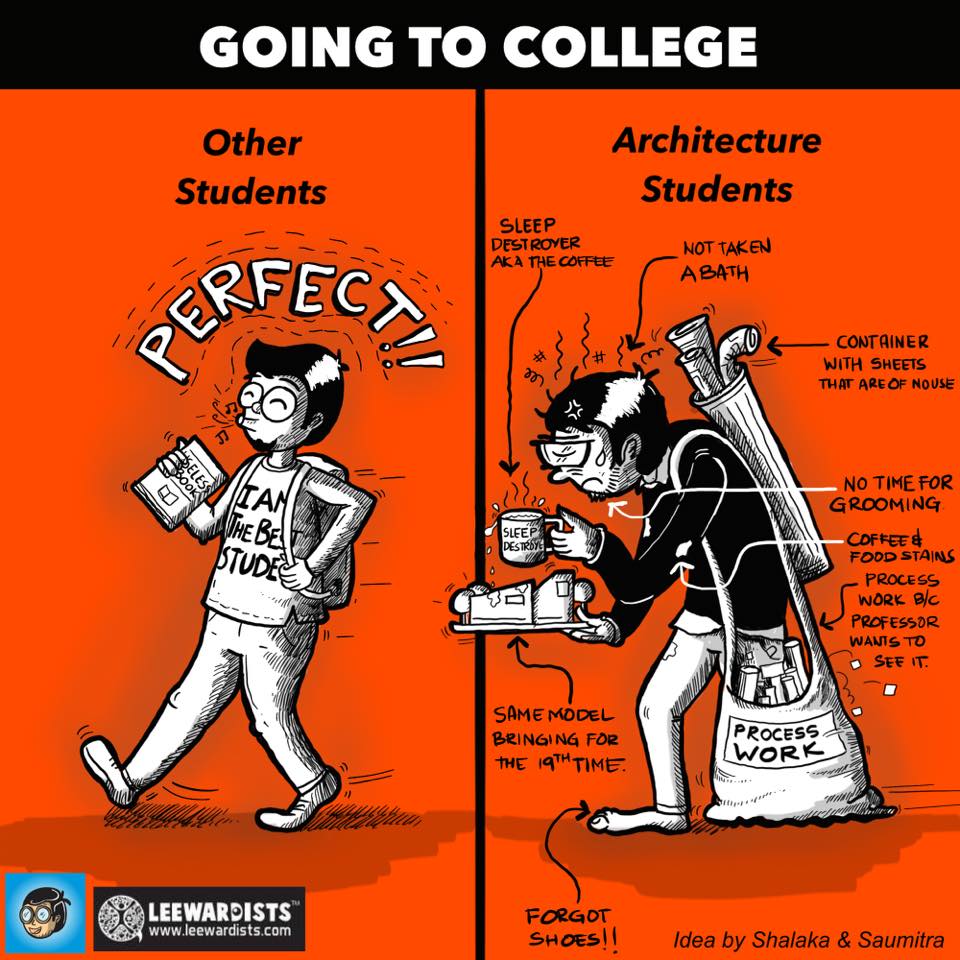
When each of us chose to pursue architecture at IITR, we lacked adequate information about all that the course would entail. This article is an attempt to consolidate and present relevant information in the interest of the incoming freshmen.
This piece shall answer two important questions:
How to get into the Bachelor of Architecture (B. Arch) program?
What to expect once you’re here?
In order to be eligible for the B. Arch program, one has to
(i) Have obtained a rank in the JEE Advanced (no other rank is considered for admission).
(ii) Appear for the Architectural Aptitude Test (AAT).
One may appear for the AAT at any of the 7 “zonal” IITs (Delhi, Kanpur, Bombay, Roorkee, Kharagpur, Madras or Guwahati). The test will be held on 14th June 2018. The syllabus can be found here.
Things you need: JEE Advanced Admit card, Pencils (2H, HB, 2B), Eraser, Pen, Colours (crayons, colour pencils).
Disclaimer: Allotment of seats is done purely on the basis of one’s AIR in the JEE Advanced; one is only required to “pass” the AAT. Your score in the AAT has no bearing whatsoever.
The standard definition – offered by a number of dictionaries – proclaims architecture as “the art and science of designing buildings, open spaces and physical structures”; however, to fully appreciate the definition, one needs to understand the keywords better.
Art: Space is the central aesthetic consideration in architecture. Although an abstract concept, it can be understood as the enclosure within which one is positioned. The architect’s duty is to design this void to make it beautiful (the best he/she can), for external beauty is the surest way of establishing a connect with the layman.
Science: The scientific component of architecture comprises a combination of principles and quantitative problems (numericals), with the former predominating. Architecture has several logical considerations, some of which are climate, cost (of construction, of running), making sure the structure/ building does not collapse and constructing whatever has been designed.
Design: Design consists of juggling aesthetic, practical and several other parallel considerations to arrive at the best possible solution. To design is to solve a problem by reaching an optimum trade-off between conflicting factors. For example, in architecture, one has to consider the sequence of spaces/rooms (their connectivity with each other), the climate, the cost, the materials that ought to be employed, the quality of spaces, etc. and produce a design that pacifies each need sufficiently.
Note: The question itself is subjective. Perhaps when you are further along in your journey of becoming an architect, you shall have formed your own unique opinions about it; the definition offered above is (intended to be) a very crude one.
MYTHBUSTER
Contrary to popular belief, architecture is not all about drawing, painting, and the like; although these are helpful skills during the course, they play a very preliminary role in design, and can nevertheless be picked up after joining the course. One does not need to be creative in the visual sense to take up architecture as a profession.
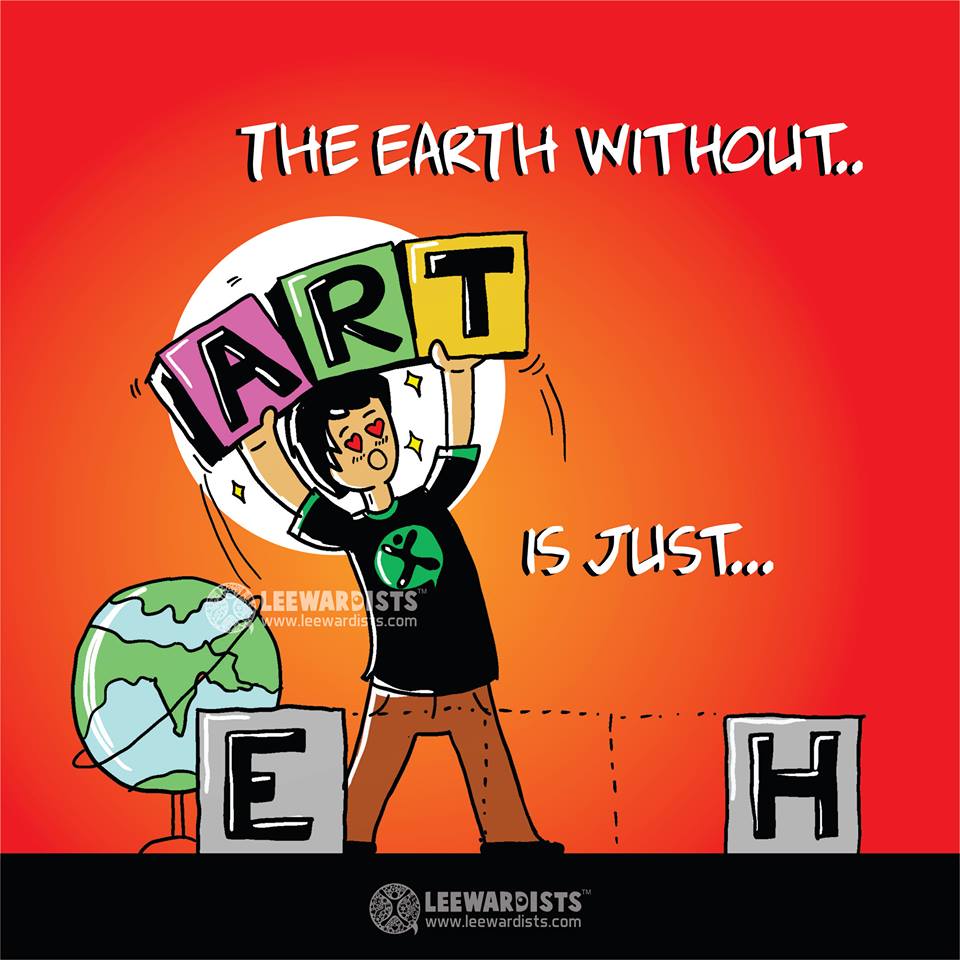
The study of architecture requires one to be a skilled generalist; a jack of all trades, who can combine knowledge from diverse fields and translate it into thoughtful spaces which speak to the people. The course is therefore designed in a manner to expose us to a vast variety of topics.
The constituent courses of the bachelor degree (as ascribed by the Council of Architecture) are centred around “Architectural Design”, which will be found in all semesters except 1.1, 4.2 and 5.2. In the fifth year, one works on their Thesis, a culmination of all skills acquired during the last four years, where he/she designs a building from start to finish, just as one would for an actual project. Other courses impart necessary skills and information required in order to design and actually construct a building. A full list of courses – and details about them – can be found here.
Architectural Design has the highest number of credits in any given semester. Designing - in general - involves solving the biggest of problems while paying attention to the minutest of details. A design needs to work and serve its purpose, preferably having an edge over conventional designs. An attempt to arrive at such a solution entails a great deal of thought. While thinking, brainstorming and conceptualising are extremely pleasurable, there will often be problems in each design, resulting in patches of frustration; in architecture, passion and frustration are inseparable.
Designs are evaluated through/by a jury, where professors – and sometimes peers – criticize each design while the designer attempts to justify his decisions. Juries may severely damage egos or ignorance, depending on how one takes the criticism. Juries are the primary means of progress for any architectural design course.
The course as a whole is rather challenging. It involves the longest contact hours of all courses and a great load of assignments (resulting in a number of late nights), both of which eventually decrease. Good grades call for a great deal of consistency in submissions above anything else.
For people who have studied the sciences all their lives – presumably with much interest and love – this shall be a very different ball game. While this transition may make for a refreshing change, it does pose its fair share of challenges in its initial stages.
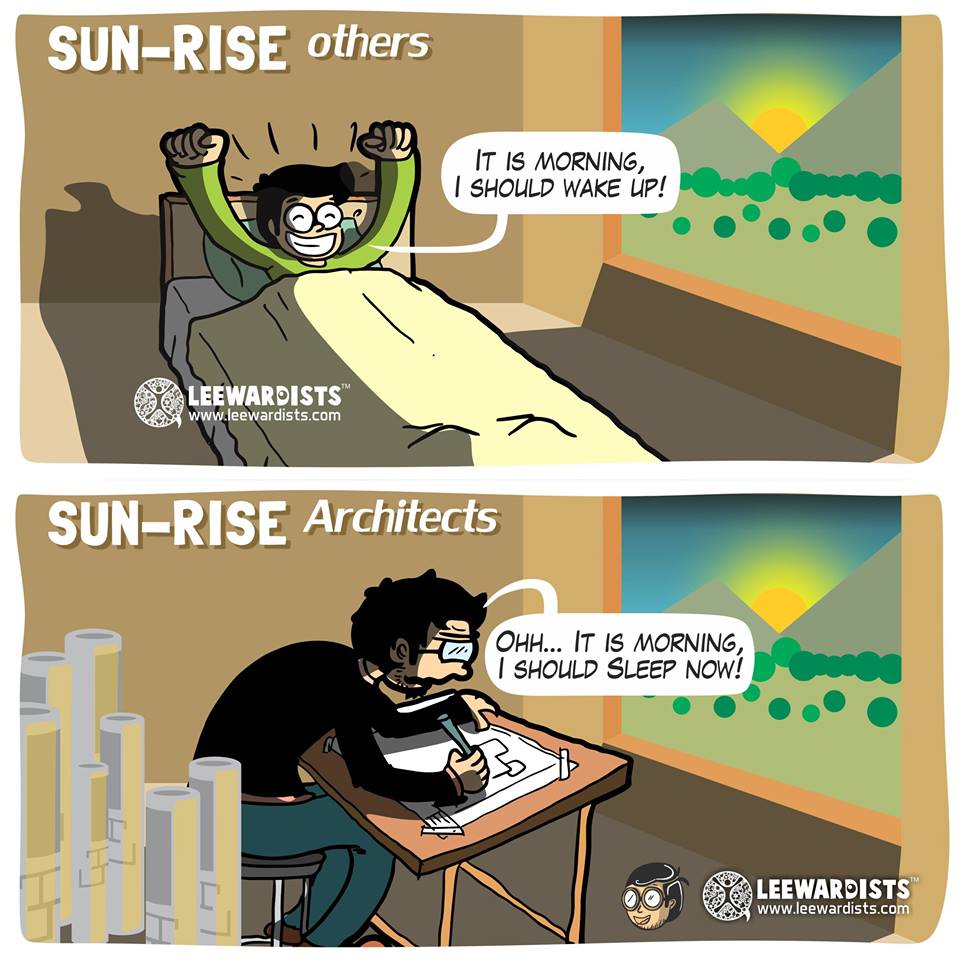
The “Family” system: All first years are inducted into one or more families within the initial two weeks of joining IITR. A family consists (mostly) of one student from each year. One can be adopted on any number of criteria, or even at random (by chit-picking). Your family is your first point of contact should you fall into any kind of trouble. It is a “baap’s” duty to give chaapos and advice on things from career options and dating tips to surviving architecture and life in general .
The Studio: Each year has its own studio which is essentially a large room where they do their drafting and other classwork. This room (and the Department of Architecture and Planning) is open 24x7, and it steadily becomes a second home for the class. This where we host midnight birthday parties and work for hours at an end.
Curious Columns: The spring semester of 2018 saw the birth of “Curious Columns”, a department group that aims to bring passionate students together for discussions and workshops, and aims to provide a platform to share knowledge, ideas and opportunities to work with each other. A detailed manifesto can be found here.
Togetherness: Each batch is a closely knit unit. This can be attributed to their small size, as well as numerous, recurring group assignments. Archi waale are almost always seen together at different spots on the campus; by the end of the second year or so, one establishes a deep familiarity with the rest of the batch, something that is peculiar only to Architecture.
Architecture at IITR has many unique advantages. These are:
A chance to make another field/skill your profession: Even if one discovers that architecture isn’t their cup of tea, many alternate options present themselves. Related fields include product design, graphic design and industrial design exist; those bearing little resemblance to architecture include coding, finance, consultancy and start-ups, to name a few. Self-interest and effort are primary requirements in such an undertaking, but campus groups and seniors help greatly. One can build his CV by interning in capacities closely related to the profession he/she wishes to pursue. Interns are much easier to come by with the help of the IIT tag. This is a good point in time to reiterate that very few people in any given batch choose architecture as their profession; the rest go into non-core jobs (we even happen to know people who want to pursue filmmaking after they graduate).
Societies, groups and sports: Although architecture constitutes a very small number of the total intake, archi waale log can be found in most groups on campus. The reasons behind joining societies and groups stand as two polar opposites: some see them as opportunities to counter frustration, while others see them as opportunities to learn relevant skills, having discovered their disinterest in architecture. Either way, the number of groups and societies on campus is astronomical, with new ones cropping up every year. Chances are there is a group for each interest or intrigue you possess (an exhaustive list with brief information can be found here). Similarly, facilities for all major sports are available, along with exceptional coaching staff that bring out the best in you. More information can be found here.
A diverse friend circle and chances to collaborate: By virtue of having a wide array of departments, IITR will bestow upon you a phenomenally diverse set of friends and acquaintances over the course of five years, resulting in interesting, insightful conversations. One has the opportunity to meet and interact with people involved in pursuits ranging from artificial intelligence to music to research to finance to consultancy. There is, therefore, a chance to collaborate with any of the above people for interdisciplinary projects.
Tinkering Lab: The tinkering lab, as the name suggests, is a lab where students can work on projects. it is equipped with state of the art tools, for example, industrial 3d printers. More information is available here.
The TIDES Business Incubator: The tides business incubator aims to help young start-ups grow. If you have a business idea, you can go to these guys and they’ll provide you with a workspace, mentorship and even help you get funds. More information is available here.
Semester Exchange: A semester exchange is available for students having a decent CGPA (>7.5) with Hochschule Luzern (Lucerne University of Applied Sciences and Arts), Switzerland, in their 7th semester (4.1). This is an opportunity to learn how our western counterparts perceive and approach architecture, as well as to travel Europe and experiencing what it has to offer. Here is an account of the experience, as recalled by a senior who visited Hochschule Luzern the year before last.
Research opportunities: Perhaps one characteristic that sets IITR apart from all other colleges is the emphasis it lays on research. Any student interested in research may approach a professor, consult him/her about the area/matter he wishes to investigate (not necessarily architecture) – and once he/she has the blessing of the professor – pursue it. A program called SURA (Summer Undergraduate Research Awards) is also in place (which has a somewhat drawn-out application process). For students of architecture, an additional opportunity lies in the form of the CBRI (Central Building Research Institute), which, although an autonomous body, abuts our campus, and is very welcoming of IITR students wishing to undertake research; three seniors to our knowledge have written research papers under the CBRI.
On-campus placements: Reportedly (that is, with questionable certainty), other architectural colleges do not have placements, or any sort of arrangements wherein graduates can find firms to employ them. At IITR, such a system does exist, but the number of firms and companies that recruit architects are just sufficient. However, when it comes to other fields such as the ones mentioned earlier, it is a level playing field, and architecture graduates can get non-core jobs provided they are meritorious. More information can be found here.
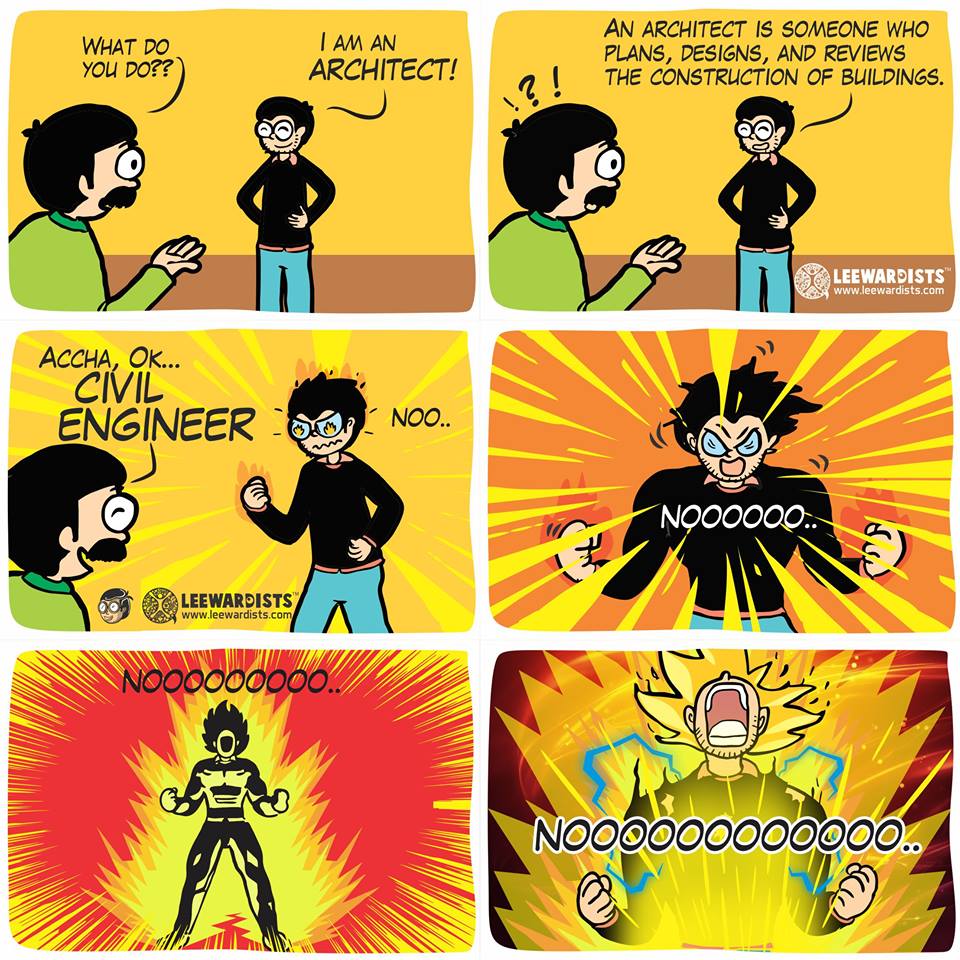
If pure, unadulterated architecture is what you are interested in, IITR is perhaps not the best place to pursue it. A list of reasons are given below:
Lack of competition: Out of the thirty-something classmates that will constitute your class (most colleges have at least 70), very few will actually be interested in architecture. A great number of them shall turn in a very poor quality of assignments – if they do – aiming at just keeping their heads above the water. There is a tendency for the “good students” to become too self-sure and become mediocre.
Focus of the professors: Unlike other colleges of architecture, the primary focus of professors in IITR is their body of research. All professors are highly qualified (holding at least a M. Arch degree; most have a PhD), albeit in their specific fields of interest. Only a handful of professors actually put in effort to keep the class interesting and impart relevant and sufficient knowledge. At present, there are only two visiting professors (practicing architects), who are infrequent with their visits. At top architecture schools such as SPA Delhi, this ratio is almost reversed; the design studio and juries are held and evaluated by practicing architects, who have an idea of the real world, of what really works and what doesn’t.
Not enough emphasis on design: Architectural design, as stated earlier, is central to the entire curriculum. However, there are only 9 hours allotted to it per week (less than any top architecture school in the country). Such a setup requires that the designing be done after class-hours, keeping the 9 hours only for discussions (on ongoing design iterations). This is hardly the case; most students procrastinate, resulting in collective underachievement.
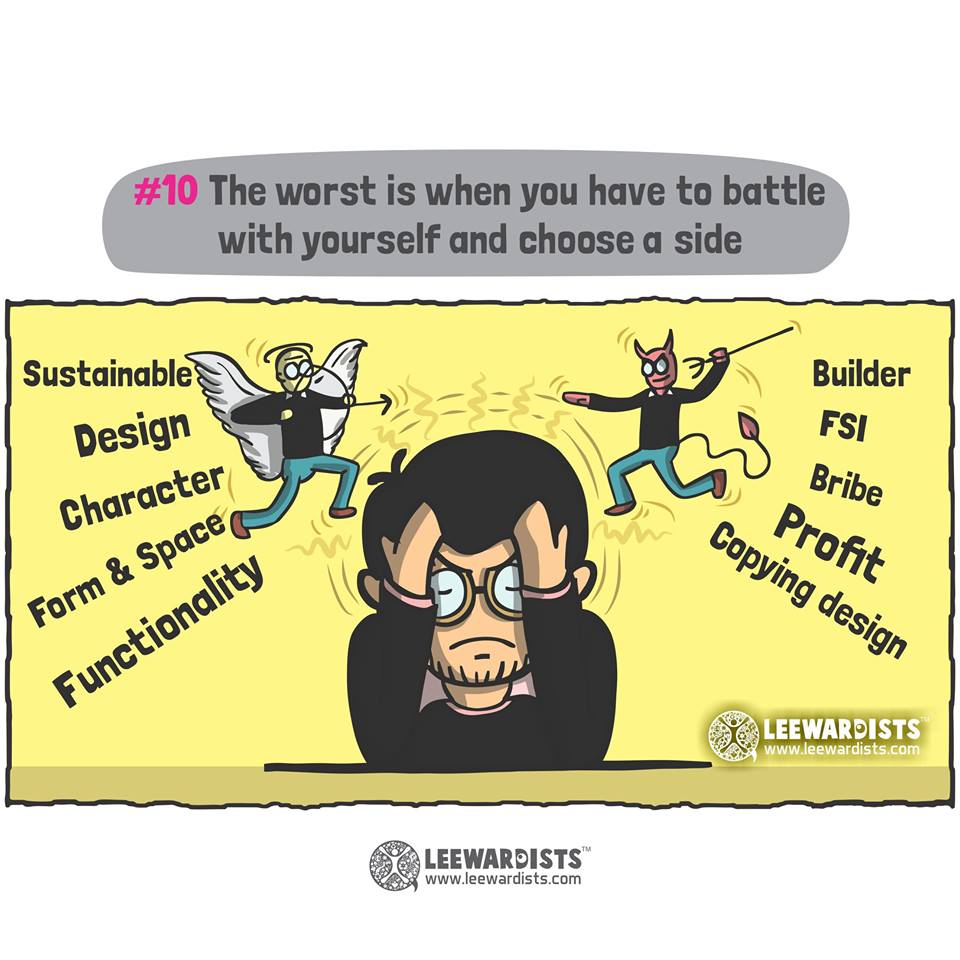
In case you have any doubts regarding the course that you wish to get clarified, feel free to call any of the people listed below:
Divyang Purrkayastha (3rd year): +91 9560588732
Ramachandra Reddy (4th year): +91 9557902784
Lanka Adarsh (4th year): +91 9410577752
Anshul Rathore (5th year): +91 9917026076
Illustration Credits: Leewardists